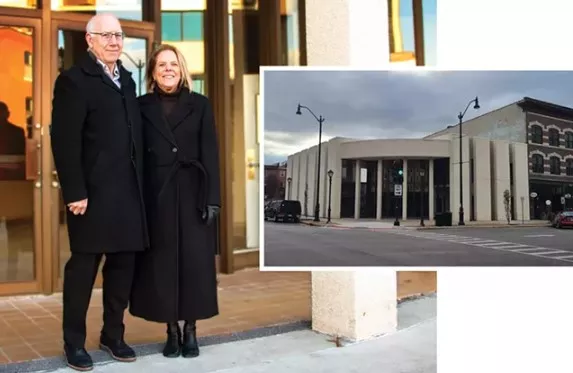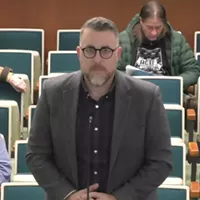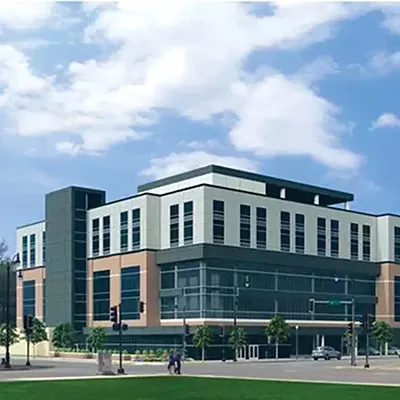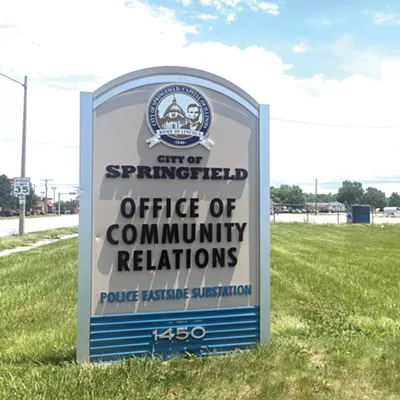
In recent years the section of downtown known as the Adams Family has been a vibrant focal point of revitalization efforts. But following a devastating fire over the summer, there are now concerns about demolition plans, failed efforts to showcase spaces in need of renovations and a stalled project that could serve as a catalyst for Adams Street.
A pending renovation project
Martin and Laurie Haxel moved their consulting and law offices downtown in 2015 and fell in love with the 300 block of East Adams Street. "We've bought six buildings and sold one already," Laurie Haxel said. While the couple didn't initially plan to purchase multiple properties, Haxel said, "We love downtown Springfield."
The Haxels funded the rehabilitation of the buildings with their own capital. A variety of businesses such as Whimsy Tea, The Keep Store and Moxie Massage populate the main levels while the upper floors have been transformed into beautiful living spaces. The two apartments at 312 E. Adams St. received the Downtown Springfield Inc. award for best residential redevelopment in 2023.
Haxel said that, at first, the former savings and loan building at the corner of Fourth and Adams streets stood out like a sore thumb, a modern building among the many historic properties on the block which are more than a century old. "But it grew on me," said Haxel. "What we really want is to see it developed and see people come downtown."
In November, the Haxels presented a proposal to the city's Economic and Community Development Commission, requesting $1.5 million in tax-increment financing to help renovate the dilapidated building at 322 E. Adams St., which has been vacant for more than three decades. In 2020, a group of local investors announced plans to turn it into Public Market, a food hall with a rooftop bar, but that didn't materialize.
The Haxels purchased the building in May 2023 for $435,000 through their limited liability company, Lexah Inc. The couple recently finished replacing the roof and have worked with architect John Shafer to compile a $3 million scope of work that includes interior demolition, new HVAC, plumbing and electrical service, elevator modification and replacement and interior finishes, in addition to exterior updates.

"The idea of TIF is that the market doesn't support the full cost of renovation because the project is in a distressed area of town," said Abby Powell, director of business development for Springfield Sangamon Growth Alliance, who previously served as the TIF administrator for the city of Springfield. "A bank would not be able to lend against the full cost because a project wouldn't appraise out to get funding from a traditional lender. This is called gap financing because it's a gap between what the market supports and what the project requires."
The Haxels' TIF request was met with unanimous approval and much encouragement from the ECDC members, but the couple believes it has not moved forward due to their request for TIF assistance to cover 50% of the project, as opposed to a more typical 30% funding request.
According to Powell, the 30% standard is not inflexible. "It's not a rule. It's not written in state statute or in city code. It has been a guideline, but there have been projects the city has supported that were higher and lower than that," she said.
Following the Haxels' presentation, Val Yazell, then-director of the city's Office of Planning and Economic Development, told the commission: "This is a bigger (TIF) ask than we've had in a long time, but there's nothing in the state statute that says you can only request a certain amount."
She noted that the downtown TIF, which has already been renewed twice, will expire for good in six years and said that the tax base in the TIF district has been trending downward due to increased vacancies and demolitions.
"We have to look at what's best for the taxing bodies... otherwise, we let (this building) sit, and at the end of the TIF, there's going to be nothing," Yazell said. She retired from her position as of Dec. 31.
Haxel noted that with the cost of the already completed roof replacement factored in, the TIF request is closer to 40% of the total cost. She also pointed out that construction costs have increased more than 50% since 2020, which she said makes the TIF guideline of 30% obsolete.
Ward 5 Ald. Lakeisha Purchase attended the November ECDC meeting to express support for the Haxels' project and is sponsoring the ordinance to request TIF assistance but declined to speak to Illinois Times about it.
Buscher said that as far as she is concerned, the 50% request is not problematic, noting that a project from another TIF district was funded at that level. "It really depends on each TIF and each project," she said.
Buscher said she met with the city's legal department Jan. 7 and "gave them the information to put the ordinance together. ... I sent the document to Laurie (Haxel) to verify for all the dollar amounts, and if that document doesn't change, that will be the requested amount."
The Haxels were initially told their project would be discussed at the Dec. 3 City Council meeting, but it has yet to appear on the agenda. At the time of their November presentation, there were no other outstanding requests for the Central Area TIF, which covers the downtown area, but they have been told there are now three additional requests in the queue.
The Haxels said they have been prepared to begin the construction process since November, with their bank financing already arranged as a prerequisite for applying for TIF funds. Every month brings more frustration at the delays.
"We're ready to move forward, more than ready," said Haxel. "Politics is politics. I get it."
A fire-damaged block
Across the intersection of Fourth and Adams streets, the 400 block of East Adams Street has been closed to vehicular traffic since the June 19 fire that ravaged the building at 413-415 E. Adams. Demolition didn't begin until November, as engineers had to stabilize the adjacent buildings first.
Chris Nickell owns the building that burned, as well as the one to the west, 411 E. Adams St., which previously housed Cafe Moxo. He said the recovery has been a long process.
"If you'd asked me after the fire, will this be cleaned up by Christmas, I'd say definitely. But here we are," he said. "Every step seems to take four to six weeks, when you think it should take seven to 10 days."
Nickell said the renovations at the former Cafe Moxo building should be finished by mid-January. Though Mark Forinash has announced plans to relocate Cafe Moxo to the west side, Nickell hopes to bring in another restaurant tenant as soon as possible.
Regarding the now-demolished building that caught fire, Nickell said, "It's too early to know how it'll all shake out, but we have goals." He said he envisions the now-empty space to be an open-air plaza utilized by the future restaurant tenant via a connecting door as well as open to the public during the Old Capitol Farmers Market.
"We'll have a fence and gate so it can be closed for private events, but I want to help create a nice space for the downtown area no matter who is using it," Nickell said.
The five-story building behind 413-415 E. Adams St. was also damaged, and Nickell said he will begin planning renovations for that building soon. His priority was to get the street-side buildings cleaned up so that Adams Street could be opened to vehicular traffic as soon as possible.
The buildings at 417-421 E. Adams St., just east of the fire, are owned by a limited liability company managed by Ben Call and Bill Marriott, who are both commercial brokers in the area. The buildings, consisting of a private parking garage on the main floor with apartments above, were heavily damaged. A demolition permit has been filed to take down the upper stories of the buildings, leaving the parking garage intact. However, it is subject to a 60-day waiting period due to its listing on the National Register of Historic Places.
The street will not be reopened until the demolition or renovation of these buildings is addressed.
"My hope is that they figure out a way to save it," said Nickell, who considers himself an advocate for preserving the historic downtown.
Call said that bids for renovating the buildings, which had office space and apartments in addition to a parking garage, were in excess of $4.7 million.
"Unfortunately, the water damage and the length of time between the fire and us getting it sorted out led to the mold damage being so great in both buildings that it wasn't feasible to try to rehab them. ... it is not a situation we can do," he said. "The limit of our insurance was significantly less than the bids we had to even partially remodel."
Scott Troehler, president of the Downtown Springfield Heritage Foundation, said the organization is opposed to the demolition and has appealed to the city's Historic Sites Commission, which has the power to deny the permit.
"They are functioning properties. We understand they need to be repaired and renovated; however, we don't feel that it's an insurmountable task," he said.
Troehler said DSHF has been exploring federal historic preservation tax credits that could be used toward renovation efforts.

"We've been working with the property owners in coming up with some financial incentives and ways they can make up the difference between apparently what the insurance is covering and the cost of repair and renovation," said Troehler.
"As an interested steward in downtown we offer whatever assistance we can, which (might include) donating the properties to us – as a nonprofit we can work on finding funding which may not be available to private property owners. We have several options. We hope they are willing to discuss with us."
Call said, "We'd be happy to entertain any discussion from the Heritage Foundation or the Historic (Sites) Commission," but based on what he's heard so far, he's not optimistic.
"What I learned was, (the incentives) would fund about 20% of a $4 million project, which would leave us with $3.2 million to fund. We received $1 million less than that as an insurance settlement. It's just a non-starter for us, given the finances," Call said.
The 60-day waiting period for the permit began when it was submitted Dec. 12. The public is encouraged to comment before the Historic Sites Commission makes its decision.
In the meantime, Troehler said, "We're optimistic we can get the Adams Street properties resolved, getting those into new owners' hands. We're hopeful we can have some conversations on moving forward and getting that block back to the vibrant section of downtown it has been for more than a decade."
A canceled art exhibit
The art exhibit "Absence and Presence – Exploring the Abandoned Cliff Hotel" was scheduled to open Dec. 4, but it was canceled the day before without explanation. The exhibit was to take place in the Cliff Hotel, a building constructed in 1894 with retail space on the ground floor and a boarding house on the second and third floors. Vacant since the 1960s, the ground floor was recently renovated by Kidzeum with the help of a grant. It now offers classrooms and meeting space and was set to be the reception area for the exhibit.
Artist and curator Robert Mazrim has been doing art installations for 30 years, and he switched his focus to including the space itself as part of the exhibit, much as he did with his recent exhibit at the former Pillsbury Mills site.
Mazrim said, "I got to see that there was all this great, empty, magical and inspiring space downtown for someone who may want to do something." After a structural engineer, a retired fire marshal and an architect said that the building was sound and hazards were mitigated, Mazrim prepared to debut the exhibit.
However, the Springfield Fire Department learned of plans for the event and deemed it unsafe since the space did not have an occupancy permit. While that is required before a property can be inhabited, Mazrim believes it is not pertinent to this exhibit.
"It's out of code because it was built in 1894, and the beauty of the place comes from it being out of code," he said. "We didn't intend to occupy it. We were going to take limited groups for the tour, for 10 minutes at a time, chaperoned."
He and Leah Wilson, executive director of Kidzeum, then held a meeting with city officials to try to find a compromise. So far that has not materialized, but Mazrim said communication is ongoing.
Wilson said she asked city officials to create an event permit that would allow for short-term, guided tours such as those offered in other cities.
"I provided some examples of other places where there is a temporary occupancy permit, and in other cities it's an event permit," Wilson said. "You're taking people into a building that may have character and a few limitations, but safety concerns have been mitigated. There are really good models in other cities for what we're trying to do."
She noted that Downtown Springfield Inc. held an annual Upper Story Tour for many years in dilapidated spaces as a way to inspire visionary developers. In addition, numerous public tours and art exhibits have taken place at the former Pillsbury Mills site, all without occupancy permits.
Mayor Buscher said her office was not involved in the decision to prohibit the art exhibit from taking place and said that directive came from the Springfield Fire Department.
"You'd have to ask if they've changed their protocol. I was not involved in any of that. If (SFD) shut it down because it was unsafe, then it was unsafe," she said.
Betsy Dollar, the executive director of Springfield Art Association who also serves as Kidzeum's board president, said that according to these new guidelines from the Springfield Fire Department, "Any unfinished space can never be used for anything until it's been restored and certified by them."
Dollar noted the goal of taking people through the raw spaces is to try to find someone who will see the vision of what it could become.
"If you can get people into these spaces, there's hope you can get people interested in these spaces," Dollar said.
A plan to move forward
Both Dollar and Wilson pointed to Springfield's long-standing lack of a city planner as a reason downtown has become so dilapidated and largely uninhabited. They noted that cities of Springfield's size often have three or more city planners, usually with one solely dedicated to a historical area or to downtown.
"We're lagging behind other cities that for decades have had credentialed, forward-pointing urban planners with expertise in growing strong cities, and who know how to curate unique experiences in their downtowns," said Wilson.
Although Springfield contracts with the Springfield-Sangamon County Regional Planning Commission for its planning, there is no planner who is specifically focused on revitalizing downtown. The city recently hired its first dedicated city planner, Sean Pritchard, who is tasked with citywide planning efforts. However, his selection has been criticized by some due to Pritchard's lack of a college degree, appropriate credentials and experience in urban planning.
"Let's prioritize the human experience. Let's create nodes of revitalization around our most unique assets and then connect them. Let's build a more integrated, sustainable, socially equitable community. Let's fertilize our cultural diversity until it flowers," Wilson said. "Perhaps if we do that, we can keep more of our talented people here and attract talent from other places, too. It's clear from recent surveys that residents want to see Springfield focus on downtown revitalization."
At the Dec. 3 City Council meeting, a representative from the urban planning firm Houseal Lavigne gave an overview of the recently completed Downtown and Medical District Master Plan. The plan was created with the participation of multiple stakeholders as well as more than 500 community members and 58 business owners, who provided input through a combination of online and in-person engagement.
"One thing that was brought to my attention is that we didn't see a lot of participation from people with kids. We need to have more families come downtown," said Ward 5 Ald. Lakeisha Purchase, whose ward includes much of downtown and the medical district.
The plan looks at downtown and the Mid-Illinois Medical District through a multitude of different lenses, with a focus on each individual asset within this area and recommendations to guide the city through planning for the next 20 years. The plan also recommends a dedicated staff person to implement the changes suggested for the study area. However, Buscher said there is no money in the budget to fund such a position, which is why the master plan has yet to be formally adopted by the City Council.
"This concept of making a resolution to adopt the plan is great, but no work group or individual has been created to make this happen. I'm not the kind of mayor who will adopt a plan just to let it sit on a shelf. We're working on making the pieces fit together," she said.
"It's not that I enjoy saying no, but I have a limited amount of money. We lost the (state) grocery tax, and that was $7 million. We just don't have the money," Buscher said.
Dollar said that when she moved to Springfield, she was excited by the potential of downtown. "It could be so cool, but nothing has happened. The whole thing remains stagnant, with more businesses moving out and moving to the west side."
Recounting a meeting with a previous mayor, Dollar said she begged that mayor to emulate other cities which put a moratorium on sprawl until downtown was revitalized. But she was told that would be political suicide.
The lack of vision is extremely disappointing, according to Dollar. "There's so much that could be done. Isn't it more expensive in the long run to let it crumble? It doesn't do much as a capital city to be a ruin."
Wilson said that committing to downtown revitalization is no small undertaking.
"Our leaders have inherited a massive challenge. The fabric of our downtown has been increasingly frayed, unraveled and tangled for decades. The approach to fixing it can't be incremental at this point, in my opinion, so if we don't marshal all of our resources, public and private, to meet this goal of a downtown turnaround, our legacy will be that of previous generations – a resignation to deterioration," she said.
As an artist, Mazrim wanted the exhibit in the Cliff Hotel to be the first of many to marry art and abandoned spaces in downtown with the hope of inspiring interest in these spaces with an eye toward revitalization.
"This kind of temporary, specialized, very well-secured use can be used to showcase and promote the potential of these historic places," said Mazrim. "It's not about preservation, it's about pragmatism. These are cool spaces. People like them."
Wilson said she hopes to bring downtown's "diamonds in the rough" back into focus as unique assets for development.
"Yes, it's possible to walk potential investors through vacant buildings, but what Robert (Mazrim) has done shines a light on the unique architecture and incredible history we have behind locked doors. It also invites us to consider what stories are yet to be told, if these buildings are just given a chance.
"I know that investment in downtown is fought so much harder than it is on the west side. For most developers, the numbers simply don't make sense. And many business owners have concluded the same – and moved. We have to change that," Wilson said.
Carey Smith is a resident of Enos Park and lives in a house as old as the Cliff Hotel. She values the businesses that currently operate in downtown and hopes for a revitalization of not only downtown, but the continued revitalization of her own neighborhood as well.














